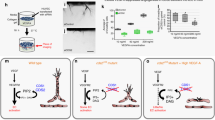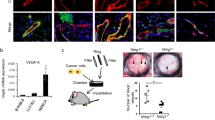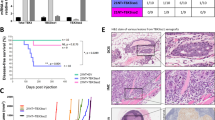Abstract
Endoglin is a transmembrane glycoprotein that acts as an auxiliary receptor for transforming growth factor-β (TGF-β) and modulates cellular responses to this pleiotropic cytokine. Endoglin is strongly expressed in endothelial cells, where it appears to exert a crucial role in vascular development and angiogenesis. Two endoglin isoforms (L and S), differing in their cytoplasmic domains, have been previously characterized in human tissues. We now demonstrate the existence of similar L- and S-endoglin variants in murine tissues with 47 and 35 amino acids, respectively, in their cytoplasmic tail. RT–PCR analysis showed that L is the predominant endoglin isoform expressed in mouse tissues, although S-endoglin mRNA is significantly expressed in liver and lung, as well as in endothelial cell lines. Furthermore, a protein of size equivalent to recombinant S-endoglin expressed in mammalian cells was detected in mouse endothelial cells by Western blot analysis. L- and S-endoglin isoforms can form disulfide-linked heterodimers, as demonstrated by cotransfection of L- and S-endoglin constructs. To address the role of S-endoglin in vivo, an S-Eng+ transgenic mouse model that targets S-endoglin expression to the endothelium was generated. The lethal phenotype of endoglin-null (Eng−/−) mice was not rescued by breeding S-Eng+ transgenic mice into the endoglin-null background. S-Eng+ mice exhibited reduced tumor growth and neovascularization after transplantation of Lewis lung carcinoma cells. In addition, S-Eng+ mice showed a drastic inhibition of benign papilloma formation when subjected to two-stage chemical skin carcinogenesis. These results point to S-endoglin as an antiangiogenic molecule, in contrast to L-endoglin which is proangiogenic.
This is a preview of subscription content, access via your institution
Access options
Subscribe to this journal
Receive 50 print issues and online access
$259.00 per year
only $5.18 per issue
Buy this article
- Purchase on Springer Link
- Instant access to full article PDF
Prices may be subject to local taxes which are calculated during checkout






Similar content being viewed by others
References
Akhurst RJ and Balmain A . (1999). J. Pathol., 187, 82–90.
Altomonte M, Montagner R, Fonsatti E, Colizzi F, Cattarossi I, Brasoveanu LI, Nicotra MR, Cattelan A, Natali PG and Maio M . (1996). Br. J. Cancer, 74, 1586–1591.
Arbiser JL, Moses MA, Fernandez CA, Ghiso N, Cao Y, Klauber N, Frank D, Brownlee M, Flynn E, Parangi S, Byers HR and Folkman J . (1997). Proc. Natl. Acad. Sci. USA, 94, 861–866.
Arthur HM, Ure J, Smith AJ, Renforth G, Wilson DI, Torsney E, Charlton R, Parums DV, Jowett T, Marchuk DA, Burns J and Diamond AG . (2000). Dev. Biol., 217, 42–53.
Barbara NP, Wrana JL and Letarte M . (1999). J. Biol. Chem., 274, 584–594.
Bellon T, Corbi A, Lastres P, Cales C, Cebrian M, Vera S, Cheifetz S, Massague J, Letarte M and Bernabeu C . (1993). Eur. J. Immunol., 23, 2340–2345.
Blobe GC, Liu X, Fang SJ, How T and Lodish HF . (2001). J. Biol. Chem., 276, 39608–39617.
Bolontrade MF, Stern MC, Binder RL, Zenklusen JC, Gimenez-Conti IB and Conti CJ . (1998). Carcinogenesis, 19, 2107–2113.
Bourdeau A, Dumont DJ and Letarte M . (1999). J. Clin. Invest., 104, 1343–1351.
Caulín C, Scholl FG, Frontelo P, Gamallo C and Quintanilla M . (1995). Cell Growth Differ., 6, 1027–1035.
Cheifetz S, Bellon T, Cales C, Vera S, Bernabeu C, Massague J and Letarte M . (1992). J. Biol. Chem., 267, 19027–19030.
Conley BA, Koleva R, Smith JD, Kacer D, Zhang D, Bernabeu C and Vary CP . (2004). J. Biol. Chem., 279, 27440–27449.
Cui W, Fowlis DJ, Bryson S, Duffie E, Ireland H, Balmain A and Akhurst RJ . (1996). Cell, 86, 531–542.
Derynck R, Akhurst RJ and Balmain A . (2001). Nat. Genet., 29, 117–129.
Diez-Marques L, Ortega-Velazquez R, Langa C, Rodriguez-Barbero A, Lopez-Novoa JM, Lamas S and Bernabeu C . (2002). Biochim. Biophys. Acta, 1587, 36–44.
Duff SE, Li C, Garland JM and Kumar S . (2003). FASEB J., 17, 984–992.
Folkman J, Watson K, Ingber D and Hanahan D . (1989). Nature, 339, 58–61.
Fonsatti E, Del Vecchio L, Altomonte M, Sigalotti L, Nicotra MR, Coral S, Natali PG and Maio M . (2001). J. Cell. Physiol., 188, 1–7.
Fonsatti E and Maio M . (2004). J. Transl. Med., 2, 18.
Frontelo P, Gonzalez-Garrigues M, Vilaro S, Gamallo C, Fabra A and Quintanilla M . (1998). Exp. Cell Res., 244, 420–432.
Ge AZ and Butcher EC . (1994). Gene, 138, 201–206.
Gorelik L and Flavell RA . (2001). Nat. Med., 7, 1118–1122.
Gougos A and Letarte M . (1988). J. Immunol., 141, 1925–1933.
Gougos A and Letarte M . (1990). J. Biol. Chem., 265, 8361–8364.
Guerrero-Esteo M, Sanchez-Elsner T, Letamendia A and Bernabeu C . (2002). J. Biol. Chem., 277, 29197–29209.
Hanahan D and Folkman J . (1996). Cell, 86, 353–364.
Haruta Y and Seon BK . (1986). Proc. Natl. Acad. Sci. USA, 83, 7898–7902.
Hasegawa Y, Takanashi S, Kanehira Y, Tsushima T, Imai T and Okumura K . (2001). Cancer, 91, 964–971.
Huss WJ, Hanrahan CF, Barrios RJ, Simons JW and Greenberg NM . (2001). Cancer Res., 61, 2736–2743.
Jerkic M, Rivas-Elena JV, Prieto M, Carron R, Sanz-Rodriguez F, Perez-Barriocanal F, Rodriguez-Barbero A, Bernabeu C and Lopez-Novoa JM . (2004). FASEB J., 18, 609–611.
Jindal SK, Ishii E, Letarte M, Vera S, Teerds KJ and Dorrington JH . (1995). Biol. Reprod., 52, 1027–1037.
Kay BK, Williamson MP and Sudol M . (2000). FASEB J., 14, 231–241.
Klein-Szanto AJ, Larcher F, Bonfil RD and Conti CJ . (1989). Carcinogenesis, 10, 2169–2172.
Lastres P, Bellon T, Cabanas C, Sanchez-Madrid F, Acevedo A, Gougos A, Letarte M and Bernabeu C . (1992). Eur. J. Immunol., 22, 393–397.
Lastres P, Letamendia A, Zhang H, Rius C, Almendro N, Raab U, Lopez LA, Langa C, Fabra A, Letarte M and Bernabeu C . (1996). J. Cell Biol., 133, 1109–1121.
Lastres P, Martin-Perez J, Langa C and Bernabeu C . (1994). Biochem. J., 301, 765–768.
Letamendia A, Lastres P, Almendro N, Raab U, Buhring HJ, Kumar S and Bernabeu C . (1998a). Int. J. Cancer, 76, 541–546.
Letamendia A, Lastres P, Botella LM, Raab U, Langa C, Velasco B, Attisano L and Bernabeu C . (1998b). J. Biol. Chem., 273, 33011–33019.
Letterio JJ and Roberts AB . (1998). Annu. Rev. Immunol., 16, 137–161.
Li C, Gardy R, Seon BK, Duff SE, Abdalla S, Renehan A, O'Dwyer ST, Haboubi N and Kumar S . (2003). Br. J. Cancer, 88, 1424–1431.
Li C, Guo B, Bernabeu C and Kumar S . (2001). Microsc. Res. Tech., 52, 437–449.
Li C, Hampson IN, Hampson L, Kumar P, Bernabeu C and Kumar S . (2000). FASEB J., 14, 55–64.
Li DY, Sorensen LK, Brooke BS, Urness LD, Davis EC, Taylor DG, Boak BB and Wendel DP . (1999). Science, 284, 1534–1537.
Liu Y, Jovanovic B, Pins M, Lee C and Bergan RC . (2002). Oncogene, 21, 8272–8281.
Massagué J . (1998). Annu. Rev. Biochem., 67, 753–791.
Massagué J, Blain SW and Lo RS . (2000). Cell, 103, 295–309.
McAllister KA, Grogg KM, Johnson DW, Gallione CJ, Baldwin MA, Jackson CE, Helmbold EA, Markel DS, McKinnon WC, Murrell J, McCormick MK, Pericak-Vance MA, Heutink P, Oostra BA, Haitjema T, Westerman CJJ, Porteous ME, Guttmacher AE, Letarte M and Marchuk DA . (1994). Nat. Genet., 8, 345–351.
Moustakas A, Pardali K, Gaal A and Heldin CH . (2002). Immunol. Lett., 82, 85–91.
Obeso J, Weber J and Auerbach R . (1990). Lab. Invest., 63, 259–269.
Oft M, Peli J, Rudaz C, Schwarz H, Beug H and Reichmann E . (1996). Genes Dev., 10, 2462–2477.
Pertovaara L, Kaipainen A, Mustonen T, Orpana A, Ferrara N, Saksela O and Alitalo K . (1994). J. Biol. Chem., 269, 6271–6274.
Pichuantes S, Vera S, Bourdeau A, Pece N, Kumar S, Wayner EA and Letarte M . (1997). Tissue Antigens, 50, 265–276.
Portella G, Cumming SA, Liddell J, Cui W, Ireland H, Akhurst RJ and Balmain A . (1998). Cell Growth Differ., 9, 393–404.
Portella G, Laezza C, Laccetti P, De Petrocellis L, Di Marzo V and Bifulco M . (2003). FASEB J., 17, 1771–1773.
Quackenbush EJ and Letarte M . (1985). J. Immunol., 134, 1276–1285.
Quintanilla M, Ramirez JR, Perez-Gomez E, Romero D, Velasco B, Letarte M, Lopez-Novoa JM and Bernabeu C . (2003). Oncogene, 22, 5976–5985.
Raab U, Velasco B, Lastres P, Letamendia A, Cales C, Langa C, Tapia E, Lopez-Bote JP, Paez E and Bernabeu C . (1999). Biochem. J., 339, 579–588.
Rodriguez-Peña A, Eleno N, Duwell A, Arevalo M, Perez-Barriocanal F, Flores O, Docherty N, Bernabeu C, Letarte M and Lopez-Novoa JM . (2002). Hypertension, 40, 713–720.
Sanz-Rodriguez F, Guerrero-Esteo M, Botella LM, Banville D, Vary CP and Bernabeu C . (2004). J. Biol. Chem., 279, 32858–32868.
Siegel PM and Massagué J . (2003). Nat. Rev. Cancer, 3, 807–821.
St-Jacques S, Cymerman U, Pece N and Letarte M . (1994). Endocrinology, 134, 2645–2657.
Takahashi N, Haba A, Matsuno F and Seon BK . (2001). Cancer Res., 61, 7846–7854.
Torre-Amione G, Beauchamp RD, Koeppen H, Park BH, Schreiber H, Moses HL and Rowley DA . (1990). Proc. Natl. Acad. Sci. USA, 87, 1486–1490.
Tuxhorn JA, McAlhany SJ, Yang F, Dang TD and Rowley DR . (2002). Cancer Res., 62, 6021–6025.
Velasco B, Ramirez JR, Relloso M, Li C, Kumar S, Lopez-Bote JP, Perez-Barriocanal F, Lopez-Novoa JM, Cowan PJ, d'Apice AJ and Bernabeu C . (2001). Gene Ther., 8, 897–904.
Waite KA and Eng C . (2003). Nat. Rev. Genet., 4, 763–773.
Yamashita H, Ichijo H, Grimsby S, Moren A, ten Dijke P and Miyazono K . (1994). J. Biol. Chem., 269, 1995–2001.
Yuspa SH . (1994). Cancer Res., 54, 1178–1189.
Zhang H, Shaw AR, Mak A and Letarte M . (1996). J. Immunol., 156, 564–573.
Acknowledgements
We thank Sebastián Aliño, Benilde Jiménez and Amparo Cano for their generous gifts of cell lines. We also thank Annette Düwell for helping with mouse breeding and genotyping and Cristina González for skilful technical assistance. This work was supported by grants from ‘Ministerio de Educación y Ciencia (SAF2004-04902 to MQ, SAF2004-01390 to CB and BFU2004-00285-BFI to JML-N), ‘Fondo de Investigación Sanitaria’ (ISCIII, Red de Centros de Cáncer RTICCC (C03/10) to MQ and PI020200 to CB). EP-G was the recipient of a predoctoral fellowship from the ‘Communidad Autónoma de Madrid’.
Author information
Authors and Affiliations
Electronic supplementary material
Rights and permissions
About this article
Cite this article
Pérez-Gómez, E., Eleno, N., López-Novoa, J. et al. Characterization of murine S-endoglin isoform and its effects on tumor development. Oncogene 24, 4450–4461 (2005). https://doi.org/10.1038/sj.onc.1208644
Received:
Revised:
Accepted:
Published:
Issue Date:
DOI: https://doi.org/10.1038/sj.onc.1208644
Keywords
This article is cited by
-
S-endoglin expression is induced in hyperoxia and contributes to altered pulmonary angiogenesis in bronchopulmonary dysplasia development
Scientific Reports (2020)
-
Effects of Chlorella vulgaris on tumor growth in mammary tumor-bearing Balb/c mice: discussing association of an immune-suppressed protumor microenvironment with serum IFNγ and IgG decrease and spleen IgG potentiation
European Journal of Nutrition (2018)
-
The role of endoglin in post-ischemic revascularization
Angiogenesis (2017)
-
Impaired Wound Repair in Adult Endoglin Heterozygous Mice Associated with Lower NO Bioavailability
Journal of Investigative Dermatology (2014)
-
In vitro and in vivo effects of an anti-mouse endoglin (CD105)–immunotoxin on the early stages of mouse B16MEL4A5 melanoma tumours
Cancer Immunology, Immunotherapy (2013)



